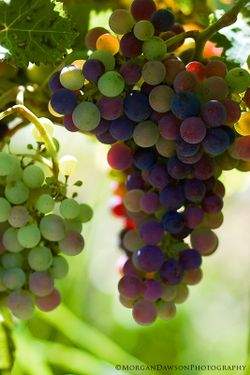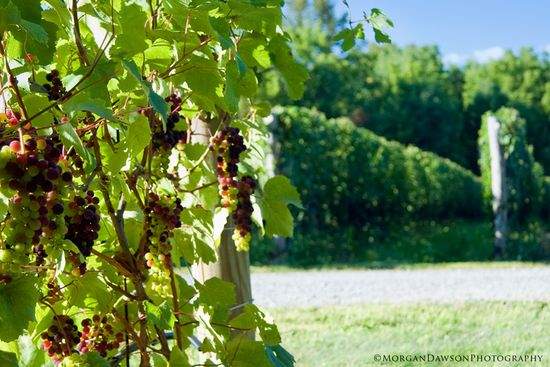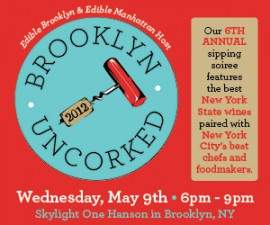Finger Lakes 2009 Vintage: Working Hard for a Happy Ending
By Evan Dawson, Finger Lakes Editor
Photos by Morgan Dawson
Just as hailstorms and cold snaps are destructive to a vineyard, sweeping generalizations are destructive to a harvest report. This year, more than any in recent memory, it is nearly impossible to describe the Finger Lakes pre-harvest conditions in one or two declarative statements. That's because Mother Nature did some — let's just call it like it is — weird, weird stuff this year.
Take the case of Hermann J. Wiemer, which utilizes three vineyards on Seneca Lake. One of them, the HJW vineyard behind the winery itself, endured a recent week in which every afternoon featured a burst of rain that could float your boat (though it hardly floated the boat of local growers). Just 10 miles north, the other two Wiemer vineyards saw nothing more than one passing sprinkle. It was like driving from tropical Florida to arid Arizona in the amount of time it takes Pink Floyd to finish one song.
So yes, conditions vary from vineyard to vineyard, from mesoclimate to mesoclimate. And yes, a lot can change. This piece is an effort to set the stage for what is to come.
"We might not see a single drop of rain until mid-September," says Rochester WHAM-TV meteorologist Mark McLean, inadvertently setting off a celebration across the region. But the challenges started months ago, and while September and October weather matter the most, don't let anyone tell you the early-summer weather means nothing.
"Later blooming varieties like riesling and cabernet franc were largely hit by rain and some cooler temperatures," explains Anthony Road Wine Company winemaker Johannes Reinhardt. He's not talking about veraison; he's talking about spring bloom, when turbulent weather first arrived. "In the worst case, it can mean lighter and smaller clusters."
Why does that matter three months later? Because some of the berries will be small enough that they won't fully ripen. The photograph to the right shows cabernet franc at Anthony Road. Some of the berries are much smaller and won't reach full ripeness. Other clusters show gaps in the grapes with strong variations in berry size. That's not a disaster if the winery knows how to handle it. There are two ways to do it, according to Reinhardt.
"You can hand harvest and hand sort, removing the problems," he says. "But most operations don't have the resources for that, so it comes down to the crusher. If they crush everything as normal it could mean some highly acidic berries get crushed too — and too much acidity in the wines. But if they adjust the crusher to only break the berries of a certain size, problems can be avoided. It's delicate, but if it's done right then the problems of June can be corrected."
In other words, the right winemaker can make all the difference. It's not just the grower. Ah, but the winemaker won't stand a chance if the grower made mistakes, because…
Canopy management will be a huge factor
Ripening lagged from the start, and at one point growers were talking about being two weeks behind ripening schedule. A heat wave to start August sped things up, and now most growers agree that ripening is about five days behind schedule. But just how far behind each vineyard is depends on how growers managed canopies.
"It was a lot of work, but we think we've gotten it to being close to on schedule," says Mike Schnelle of Red Tail Ridge. The main photograph above shows Red Tail Ridge's vines, which looked strong this week. Schnelle has carefully managed canopies to make sure grapes were getting the right sun exposure after an abnormally cool and wet first half of summer.
White Springs Winery's Derek Wilber shot this video to help other growers see how to handle the challenge.
Hybrid growers explain that canopy management was less an issue for them. "With my seyval I didn't do anything different with the canopy," explains Ray Emery, whose Emery Vineyard supplies the seyval for McGreogor Vineyard and Winery on Keuka Lake. "Some of the vinifera folks most likely paid more attention to leaf removal. We are getting ready to go remove the lagging fruit. It will make a difference at harvest."
Regardless of what's already happened, there is a noticeable bounce in the step of Finger Lakes growers and winemakers, because…
September might provide the Cinderella Story
"We were picking grapes in 2000 that made wine that evoked V8 Juice," says Fox Run Winery winemaker Peter Bell. "Trust me, 2009 is not only nothing like that, we'd be fine even without this incredible September weather. Everyone would prefer to be ahead of where we were at the end of August, but this is not unique."
In fact, the extended September forecast of relentless sun, 82-degree highs and 52-degree lows is "absolutely a dream," Bell says. Ripening is catching up in many places, and the warm days and cool nights could provide some excellent structure.
But there's another reason for optimism. Because of the heavy unsold local grape and wine inventory, some growers cut croploads this year — even before the rough early summer weather. That's the case at Anthony Road, where all vineyards now feature two fruiting canes instead of four. Reinhardt figures that will cut down the cropload by about 25%. And that means potentially richer, more complex wines — along with a vineyard that is better equipped to handle challenging conditions. "This was the opportunity to reduce croploads," Reinhardt says. "It's not happening in all vineyards, but you'll notice a difference where it is happening."
So it's too early to declare this an outstanding vintage or a junky one, but it's not too early to say that more than many years, the better wines this year will come from the best vineyards AND the winemakers with a deft hand after picking. Customers should learn as much as they can about the vineyard and winemaking practices behind the bottles that will eventually come out. And if the weather continues to sparkle, it will be instructive to find out when producers decide to pick. While some growers say they're certain to pick later than normal, others seem beholden to a picking schedule that might bring the grapes in before they're optimal.
And if Mother Nature gets her crazy on once again, we'll come back and reassess everything.





















Evan -
Interesting article. I’m sure it will spark some debate.
I don’t think that making a blanket statement “Dropping the crop loads by 25% will mean richer, more complex wines.”
A vine is all about balance. The SITE dictates this balance and some sites, based on nutrient and water uptake require different handling.
I realize that many writers take to crop load as the easiest point of reference for determining this “richer, more complex wine” theory. I would argue that two canes with bullwood shoots are going to make a much less desirable wine than a four cane scott-henry on a vigorous site.
Personally, I’m much happier taking fruit from a vine that I see in balance (like the shoot tips stopping growth at veraison), rather than going on the pure tons/acre numbers.
Cheers,
Tom
Tom,
Very good points. I’m basing that statement on Johannes’ very specific view that the wine is going to benefit; he has been seeking this change for some time, and for his site I trust his assessment. You’ll note, I hope, that I sought very much to avoid blanket statements in this piece. And industry professionals far smarter than me have stressed the importance of vine balance. But I’ll stand by my view that there are still too many vineyards overproducing in the Finger Lakes. Doesn’t mean it’s that way everywhere — in fact, the improvement I’ve seen in just a few years is remarkable. It’s why we can get such elegant, complex Pinot along with other world-class wines.
yea I agree, you shouldnt let the economy dictate your crop load, but Im sure there are plenty of NY vineyards that need some crop reduction regardless of the economy. Dosent supprise me Anthonies Road is seeking reduction, they are so obviously focused on top quality viniculture, they took the NYS Governor’s Cup this year with their semi dry riesling. In fact my boss just recieved a half case as a gift from them (I, however, was not offered any, sniff sniff grumble grumble)
So if I could get a bit of a survey from growers that would be great … What brix are growers harvesting Seyval at? And when? (approximate answers are acceptable)
Good discussion. I’ve long been part of the debate in NY regarding crop yields and wine quality. I’ve heard the Dr. Smart lectures that assure growers they can increase yield if they correspondingly increase canopy, etc. But rarely have I seen these techniques work well - particularly with red wines - in the glass. The theory works if you have a growing season that can provide extended sunlight and ripening conditions. Whites can surely hold a larger crop load and produce excellent wines but reds are another animal altogether.
Vine balance is very important but even with a balanced vine I’ve seen there is a limit as to how much fruit that balanced vine can ripen. The limit is determined by the climatic conditions that the vine is growing under - heat, sunlight and rainfall. Fact is at some point we literally run out of growing season. It’s no secret that colder viticultural areas typically produce wine grape yields that are lower than the same varieties produced in warmer climes. The good news is I believe our wines are better for it.
I believe yield and vine management is the limiting factor to wine quality in the northeast. The discussion on an earlier thread regarding hybrids is a case in point. Many of these varieties could make much better wine if they were cropped at more moderate levels. Acidity would be lower, flavor would be increased and the need for residual sugar for balance would be decreased.
In terms of red here on the Island, most of the best reds are produced from vineyards yielding 2-3 tons per acre. For that amount of fruit the vines can be balanced accordingly by setting more fruit and thinning later, more severe pruning etc. After all these years we’re still learning and tweaking our vineyards to find the best results. But ultimately, it’s whats in the glass that matters and should determine what your practices should be.
Rowland and Rich,
Interesting stuff, and I’ve been slowly putting together material for a future piece on exactly the subject of yields. But for now I wanted to add an idea to the mix and get your thoughts on it.
During our Finger Lakes cab franc tasting event earlier this summer, a discussion on yields took place. Hermann J. Wiemer owner and winemaker Fred Merwarth made a remark that I had not heard before, and yet makes sense to me. He said that even if the vine can be undercropped and thus off balance, only will the ensuing wine pick up more weight and mouthfeel when yields are reduced. In other words, we can discuss balance all we want, but the more fruit on the vine, the less mouthfeel and weight.
Thoughts on that? Again, this is perhaps best left for a separate post.
I think its a factor of terroir, the weather and the definition of under cropped. There is a law of diminishing returns as well- i.e. in many years a 1 ton yield will not necessarily make better wine than a 2 ton yield. You’re just loosing crop for no reason at that point. In other years, higher yields (or higher numbers of clusters per vine) will result in wines of lesser quality. Soil type also plays into it as all things being equal, some wines will just be better when grown on certain soils.
I think every place needs to do this work on their own to see what is successful in their own terroir. I do feel strongly that every region has a limit on yield with regard to quality and that limit will change depending on the location. The French had it right when they instituted the A.O.C. regs.
… see guys, you need to creat a forum.
But seriously, Seyval. What brix are people harvesting it at? I know they grow a lot of it up by you in the Finger Lakes, and here in the Hudson Valley the HVWGA makes it the primary componant of the Hudson Heritage blends (http://hvwga.com/Hudson%20Heritage%20Wine.htm). But the thing is Ive heard a few growers say they harvest it at only 16 brix (so talk about hiding the filter for Parker, how about hiding the pallets of sugar). Is this an individual choice of these growers, a style thing? or is that common practice, maybe related to over cropping as you say (but still, why even bother with a grape that only “ripens” to 16 brix?)? Please way in.